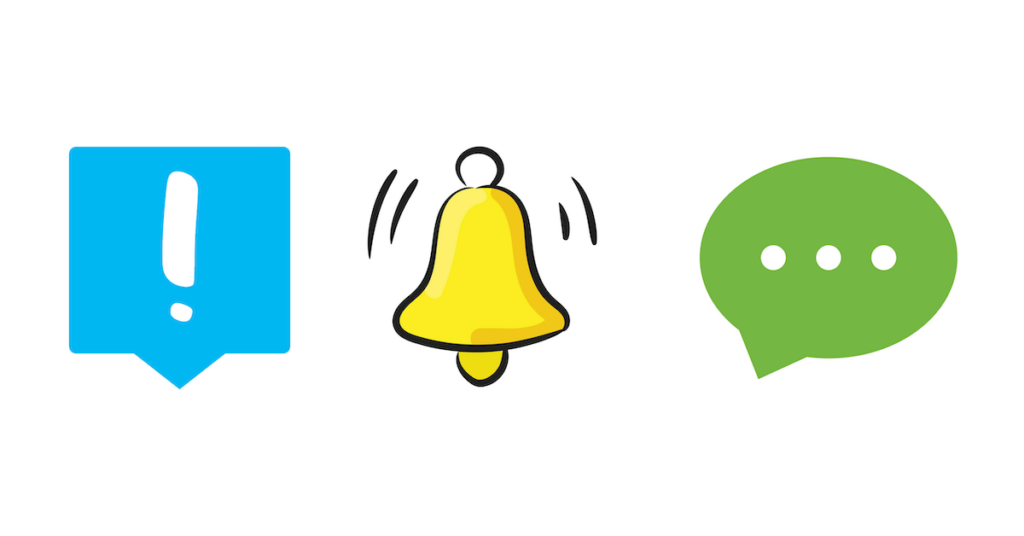Push Notifications Explained

Updated February 3, 2021
Website, or browser, push notifications can be a powerful tool for site owners looking to enhance communication with their site visitors. Read on to learn more about notifications, including the potential benefits and risks associated with using them on your website.
Types of Notifications
The primary categories of notifications are either web push notifications (also known as browser push notifications) and mobile application push notifications. While there are similarities between the two, the differences are quite striking.
Web Push Notifications aka Browser Push Notifications
Web push notifications offer a greater audience reach than mobile app push notifications because they are sent to both mobile and desktop device users, which is a boon to those looking to use notifications for marketing purposes.
Visitors have to opt-in, or accept the request to push notifications, from sites wishing to send web push notifications. Mobile apps work a bit differently (see the section below on mobile app notifications).
They work by appearing in user web browsers, so long as a browser is open. In fact, even if someone leaves your site and has gone on elsewhere on the web, they can still receive and display browser push notifications from your website.
Browser push notifications will not appear if someone has closed the browser and re-opened it. The close and open action will halt browser notifications until someone revisits the site and okays notification acceptance again.
One important facet of browser notifications is that they don’t require any software to be installed on the web visitor computer or phone. Everything is done via the browser, so it’s a leaner approach.
From a practical perspective, web push notifications are relatively straightforward to deploy, target the largest possible segment, but have some limitations such as the opt-in requirement and being effective only when the browser stays open.
Mobile App Push Notifications
By their very nature, mobile app push notifications only reach mobile devices, leaving desktop users unreachable. Being an application, there is software that needs to be installed in order for these push messages to be received by users.
Users have to allow the application to be installed, but then they can be sent notifications even when the device is locked, browser is closed or they’re doing something entirely different at the time. Apps do not need to be launched and occupy the primary focus of user activity – they just need to be installed.
Opt-in varies by device! Android devices have app notifications enabled by default, meaning users are opted in simply because they chose to install an application. Opt-out is provided as an option.
Apple devices, on the other hand, have app notifications disabled by default, so that users are opted out after installing the application, thus requiring users to opt-in if they wish to receive mobile app notifications.
Push Notifications – Good, Bad & the Ugly
Just because push notifications can be used doesn’t mean that push notifications should be used. There are some significant benefits achieved by implementing notifications, but if precautions aren’t followed, there are substantial risks involved.
Advantages of using Browser Push Notifications
Push notifications get users to take action. In fact, those receiving such notifications are 50% more likely to open and check them out, versus email open rates, and twice as likely to click through on desktops or 7x more likely on mobile devices as compared to email.
Push notifications are easy for site visitors to opt-in since there doesn’t need to be any personal information provided at the time of asking permission to send notifications.
Rather than sending information hours, days or weeks down the road, push notifications can be sent in real-time. These can be contextual so that highly targeted sale offers can be provided, pointers to other content of value and even cross references to other brand assets, like forums, wikis and social media pages.
Instead of exit intent scripts which attempt to guess that a user is about to leave your site, you can entice users back, thus improving traffic by offering them value in a reason to return. This can be anything from abandoned carts to special offers or other pertinent information.
Mobile apps are more costly to develop and deploy for providing push notifications than website browser push solutions, plus they don’t reach all devices. Browser push gives you the chance to reach all devices and at a cost effective price point compared to mobile apps.
Drawbacks or Issues in using Any Push Notifications
Excessive, unexpected and/or low value interruptions in the form of notifications can often result in a negative response.
This becomes more likely as the number of notifications (decreasing amount of time between notifications) increases.
Negative responses are also likely when the notification is presented when the user is on another website doing something else entirely.
Negative conditioning, also known as anchoring, is when enough negative experiences are accumulated without sufficient positive experiences. One negative can result in a bounce or a passing moment of anger or anxiety. Several negatives can lead to a lasting negative impression. These lasting bad impressions cost companies money in the short term and a pool of vocal brand opponents over time.
The many touted features of push notification campaigns, as presented on some 3rd party service provider websites either cost money (a monthly service subscription fee) or time (in developing all the functionality in-house yourself). These include things like:
– audience segmentation – different notifications based on the user browser, operating system, location, etc
– event or behavior driven notifications – when someone take an action, visits a page, watches a video, downloads a document, or other behavior, they get a particular notification
– personalized messages and offers – by storing additional information about user preferences and prior activities, specific personal notifications can be sent for anything (including wish out of stock items coming into stock, wish lists, similar products and related posts)
Note: App notifications tend to be more expected and hence accepted with fewer risks associated, but any notifications can become annoying under the right circumstances.

Conclusion
Following best practices, push notifications can be an effective marketing tool for site owners looking to stimulate and engage with users, drive conversions, extend retention and enhance the user experience.
Browser push notifications are easier, and cheaper, to deliver, while reaching a larger audience. If you don’t have, or feel the need for, a mobile app, then look to web push notifications as a possible way of improving your site performance.